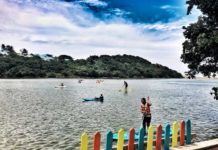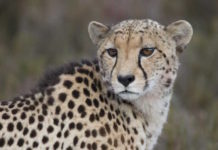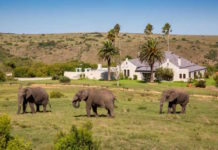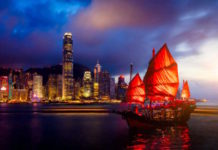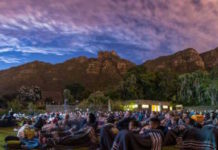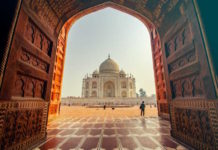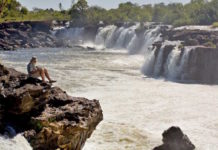The Democratic Republic of Congo is a big country with endless potential to be the leading tourist destination in Africa at large. Unfortunately, there is political instability, unrest, and bad press in the Eastern part of Congo that has scared away many tourists.
Regardless of the political instability, there is one fact that does not change, that DR Congo is endowed with rich biodiversity and rolling landscapes that make it impossible to be ignored. Congo offers unspoiled and untapped tourism in the true African wilderness. DR Congo is the only country in Africa that offers both the endangered lowland and mountain gorillas. Congo’s Other rare species include the Okapi, and the pygmy chimpanzee (bonobos). Congo’s remote tropical rainforest is the third world’s largest forest that is believed to protect wildlife species to be discovered.
- Track Mountain Gorillas at Virunga National Park
Established in 1925, Virunga National Park was established in 1925 which makes it one of the oldest national parks in Africa. It has been a protected area due to its remarkable flora and fauna. Virunga National Park accommodates the Congo’s endangered mountain gorillas. Mountain Gorilla trekking and mount Nyiragongo hiking are the two most famous tourism activities in the park. Mountain gorilla tours in Congo give tourists a major opportunity to visit the only gorilla orphanage center worldwide.
Gorilla orphanage and Senkwekwe Centre was is approximate to the Mikeno lodge with the aim of protecting the rescued gorilla orphans who had lost their parents because of poachers. Travelers can visit this orphanage Centre so that they learn more about mountain gorilla conservation and the efforts put in place by the organizations such as Gorilla Doctors that ensure the survival of this endangered gorilla species. Travelers are allowed to donate or commit to supporting one of these orphans. Virunga national park also protects other wildlife species such as chimpanzees, forest elephants, lions, golden monkeys, hippopotamus, the rare Okapi, and more than 410 bird species.
- Hike Mount Nyiragongo
Mount Nyiragongo is among the few world’s left active volcanoes. mount Nyiragongo is a prominent feature towering in Virunga National Park. Mount Nyiragongo is the only place offering visitors a chance to view the boiling lava lake up close. Mount Nyiragongo’s last major eruption took place in 2021 that left a trail of destruction in its wake where many people lost their lives, property, and more than 100,000 people become homeless.
Hiking up to the top of Mount Nyiragongo Volcano can per half take two days that involve a sleepover at the top of the Volcano. Besides marveling at Mother Nature and taking pictures of the boiling magma, prepare to eye catch the breathtaking sceneries of the Virunga National Park, the other neighboring Virunga chained volcanoes such as mount Karisimbi, mount Bisoke and Rwenzori Mountains of Uganda. A hiking permit to Mount Nyiragongo costs $450 per person.
- Spott Lowland Gorillas in Kahuzi-Biega National Park
Kahuzi Biega national park is among the Congo’s hidden treasures and another UNESCO World Heritage site. Kahuzi Biega national park is famous due to the fact that it protects the remaining two habitats of the endangered Eastern lowland gorillas that are commonly known as the “Grauer’s gorilla” which is a subspecies of the Lowland gorilla.
Kahuzi Biega national park’s most famous activity is a Lowland gorilla trekking. Kahuzi Biega national park protects more than 300 Eastern Lowland Gorillas. The best time to visit Kahuzi biega national park to go lowland gorilla trekking is during the rainy season. The gorilla families tend to move a lot during the dry season while searching for fresh food. Besides the ape’s family, expect to experience the virgin territory and wonderful landscapes that consist of mountains, tropical rainforest, lowlands, and great swamps.
- Take a Safari in Garamba National Park
Garamba National Park is a UNESCO World Heritage site situated in the Democratic Republic of Congo. Garamba national park offers a vast savannah grassland that constantly supports great herds of giraffes, cape buffalo, and antelopes. Garamba national park is remotely located that makes it receive few visitors
It is important to take caution while visiting Garamba national park because of the rebel elements led by the naughty Joseph Kony who could occasionally seek shelter in the park’s remote areas near the South Sudan border.
- Be Awed by Salonga National Park
Salonga National Park is also a classified protected area situated in the democratic republic of Congo. Salonga national park and Kahuzi-Biega national parks are the Congo’s last strongholds in protecting the Grauer’s gorillas. Grauer’s gorillas are the largest subspecies in Congo. Grauer’s are larger and heavier than mountain gorillas although, they have less fur. Congo protects more than 4,600 individuals within the highlands and tropical forests of these two national parks.
Salonga National Park offers the greatest number of Grauer’s individuals, the eastern lowland gorilla trekking is best organized and more famous at Kahuzi-Biega National Park. Salonga National park also protects other wildlife species such as forest elephants, bonobos, slender-snouted crocodiles, and peacocks.
- Go gorilla trekking at Maiko national park
Maiko National Park is one of Africa’s wonders situated in the Democratic Republic of the Congo. Maiko national park is located in remote tropical rainforest in Congo. Maiko national park covers approximately 10,885 square kilometers that have been divided into 3 sectors and spread across Maniema, province Orientale, and the states of North Kivu.
Maiko national park protects more than 800 gorillas. Maiko national park is among the three National parks in the democratic republic of Congo’s endemic animals are located which include the eastern lowland gorilla, the Congo peacock, and the okapi. In addition, Maiko national park also protects other wildlife species such as forest elephants, and leopards that reside deep in the dense forests.


